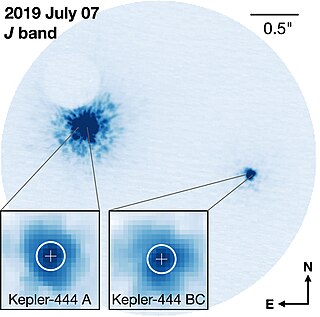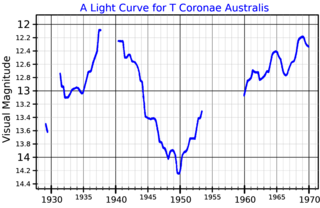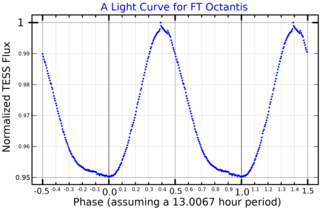
WR 7 is a Wolf–Rayet star in the constellation of Canis Major. It lies at the centre of a complex bubble of gas which is shocked and partially ionised by the star's radiation and winds.
GJ 3379 is the nearest star in the Orion constellation, located at a distance of 17 light years from the Sun based on parallax. It is a single star with an apparent visual magnitude of +11.31 and an absolute magnitude of +12.71, therefore, the star is not visible with the naked eye. It is positioned in the upper left part of the Orion constellation, to the SSE of Betelgeuse. This star is drifting further away with a radial velocity of +30.0 kilometers per second. In the past, this star had a relatively close encounter with the Solar System. Some 161,000±6,000 years ago, it achieved a minimum distance of 4.08 ± 0.20 ly (1.25 ± 0.06 pc).
Kepler-17 is a main-sequence yellow dwarf star that is much more active than the Sun with starspots covering roughly 6% of its surface. Starspots are long-lived, with at least one persisting for 1400 days.

R Equulei is a class M Mira variable star in the constellation Equuleus. Its brightness varies between a minimum magnitude of 15.0 to a maximum of 8.7 with an average period of 261 days.
HD 38282 is a massive spectroscopic binary star in the Tarantula Nebula, consisting of two hydrogen-rich Wolf-Rayet stars.

Kepler-90, also designated 2MASS J18574403+4918185, is a G-type star located about 2,790 light-years (855 pc) from Earth in the constellation of Draco. It is notable for possessing a planetary system that has the same number of observed planets as the Solar System.

Kepler-444 is a triple star system, estimated to be 11.2 billion years old, approximately 119 light-years (36 pc) away from Earth in the constellation Lyra. On 27 January 2015, the Kepler spacecraft is reported to have confirmed the detection of five sub-Earth-sized rocky exoplanets orbiting the main star. The star is a K-type main sequence star. All of the planets are far too close to their star to harbour life forms.

T Coronae Australis, is a young star in the constellation Corona Australis. It is a member of the Corona Australis star-forming region, which is located about 502 light-years (154.0 pc) from the Sun. It has a spectral type of F0e and is surrounded by a circumstellar disk, seen edge-on.
Kepler-421 is a yellow main sequence star, being of spectral class G7V. Orange star of spectral class K9V, projected on sky plane just 1.085″ away, is not physically associated to it. The distance to star KOI-1274 A is approximately 1150 light-years, and to KOI-1274 B is about 1900 light-years.

TYC 9486-927-1 is the primary of a possible trinary star system located at a distance of 26.7 parsecs from Earth in the southern direction in the constellation of Octans. It is a BY Draconis variable, with large starspots causing it to change brightness as it rotates every 13 hours.
LS IV-14 116 is a hot subdwarf located approximately 2,000 light years away on the border between the constellations Capricornus and Aquarius. It has a surface temperature of approximately 34,000 ± 500 kelvins. Along with stars HE 2359-2844 and HE 1256-2738, LS IV-14 116 forms a new group of star called heavy metal subdwarfs. These are thought to be stars contracting to the extended horizontal branch after a helium flash and ejection of their atmospheres at the tip of the red giant branch.

HD 121228 is a blue supergiant star located in the constellation Centaurus. The star is noted for its close visual proximity to the planetary nebula SuWt 2.

K2-18, also known as EPIC 201912552, is a red dwarf star with two planetary companions located 124 light-years from Earth, in the constellation of Leo.
Kepler-51 is a Sun-like star that is about 500 million years old. It is orbited by three super-puff planets—Kepler-51b, c, and d—which have the lowest known densities of any known exoplanet. The planets are similar in radius to gas giants like Jupiter, but have unusually small masses for their size, only a few times greater than Earth’s.

The Tucana-Horologium association (Tuc-Hor), or Tucana Horologium moving group, is a stellar association with an age of 45 ± 4 Myr and it is one of the largest stellar associations within 100 parsecs. The association has a similar size to the Beta Pictoris moving group (BPMG) and contains, like BPMG, more than 12 stars with spectral type B, A and F. The association is named after two southern constellations, the constellation Tucana and the constellation Horologium.
Kepler-429 is a variable subdwarf B star in the constellation Lyra, about 5,900 light years away.
Kepler-411 is a binary star system. Its primary star Kepler-411A is a K-type main-sequence star, orbited by the red dwarf star Kepler-411B on a wide orbit, discovered in 2012.
Kepler-410 is a binary star system. Its primary star, also known as Kepler-410A, is a F-type subgiant star, orbited by the orange dwarf star Kepler-410B on a wide orbit. The companion star was discovered in 2012.
BAT99-7 is a WN-type Wolf-Rayet star located in the Large Magellanic Cloud, in the constellation of Dorado, about 160,000 light years away. The star has a spectrum containing extremely broad emission lines, and is the prototype for the "round line" stars, Wolf-Rayet stars whose spectra are characterized by strong and broad emission lines with round line profiles. The broad emission lines hint at an extremely high temperature of nearly 160,000 Kelvin, which would make it the hottest of all WN stars with known temperatures, as well as an extraordinarily large mass loss rate for a Wolf-Rayet star in the LMC, at 10−4.48 M☉/yr, which means that every 30,200 years, the star loses 1 solar mass worth of mass.

WD 0810-353 is a white dwarf currently located 36 light-years from the Solar System. This stellar remnant may approach the Solar System 29,000 years from now at a distance of around 0.15 parsecs, 0.49 light-years or 31,000 AU from the Sun, crossing well within the proposed boundaries of the Oort cloud. Such close proximity will almost certainly make its flyby the closest in the future, until the flyby of Gliese 710 occurs around 1.14 million years after the dwarf's flyby.









